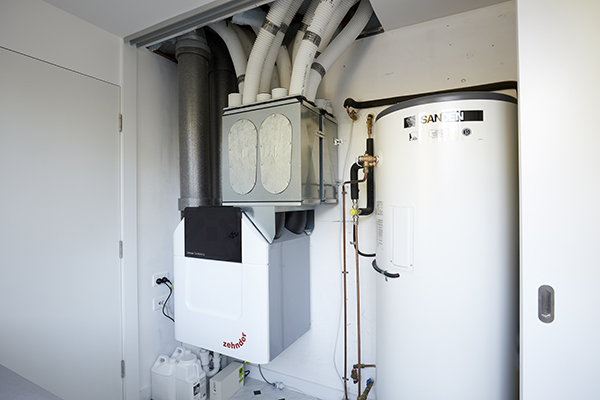Exactly How Heat Recovery Ventilation Enhances Indoor Air Quality and Reduces Energy Prices
Heat Recovery Ventilation (HRV) systems play a necessary function in boosting indoor air top quality while simultaneously lowering power costs. By efficiently exchanging stagnant interior air with fresh outdoor air, HRVs assist preserve excellent humidity and decrease toxins. Furthermore, their capacity to recover warmth from outgoing air minimizes the pressure on home heating and cooling systems. As power costs remain to climb, comprehending the complete potential of HRV systems ends up being significantly essential for home owners and organizations alike.
Recognizing Heat Recovery Ventilation Equipments

Heat recovery ventilation (HRV) systems play a vital duty in enhancing indoor air top quality, particularly in contemporary, energy-efficient structures. These systems are designed to transfer warm from the outbound stagnant air to the inbound fresh air, thereby reducing energy loss while preserving excellent temperature degrees indoors. HRVs include a warm exchanger, followers, and ductwork, promoting the continuous circulation of air. By removing indoor contaminants and presenting fresh air, HRVs assist to stabilize moisture levels, stop mold and mildew development, and minimize irritants. The performance of HRV systems hinges on their capacity to recoup approximately 80% of the warmth from the worn down air, advertising power conservation while ensuring a healthy interior atmosphere. Their combination is important in achieving sustainable living techniques.
The Relevance of Indoor Air High Quality
Indoor air quality (IAQ) is a critical variable affecting the health and health of owners in any environment. Poor IAQ can result in different health and wellness concerns, consisting of respiratory system issues, allergies, and tiredness. Furthermore, it can worsen current problems such as asthma. Aspects contributing to low IAQ include pollutants from indoor resources like cleansing agents, mold and mildew, and insufficient ventilation. Maintaining great IAQ is important for advertising a safe and comfortable living or working area. Reliable approaches to improve IAQ involve routine monitoring of air top quality, proper ventilation systems, and minimizing using dangerous compounds inside your home. By focusing on IAQ, people can ensure a healthier environment that cultivates performance and overall lifestyle.
Energy Efficiency Conveniences of HRV Equipments
Many house owners and building managers are progressively identifying the power performance advantages of heat recovery air flow (HRV) systems. By transferring warmth from exhausted indoor air to inbound fresh air, HRV systems noticeably reduce the energy required for cooling and heating. This procedure minimizes reliance on traditional heating and cooling systems, bring about lower energy expenses. Furthermore, HRVs help keep a well balanced indoor climate, preventing too much heating or cooling down demands. The capacity to recuperate approximately 90% of the warmth from outgoing air additionally sustains sustainability efforts by decreasing overall energy intake. Consequently, HRV systems contribute not only to cost savings but also to a reduced carbon footprint, aligning with the expanding focus on energy-efficient building practices.
Setup and Upkeep Considerations
The efficient execution of warm recovery ventilation (HRV) systems requires careful factor to consider of installation and upkeep elements to guarantee peak performance. Appropriate positioning of the HRV unit is important, as it should be set up in a location that makes best use of air flow while reducing noise disturbance. Furthermore, ductwork must be appropriately sized and insulated to check out this site avoid power loss. Routine maintenance, including filter replacement and system cleaning, is vital to safeguard optimum functionality and interior air quality. Owners ought to establish a regular upkeep routine to identify and address possible problems before they rise. Cooperation with experienced specialists throughout both installation and upkeep stages can enhance the longevity and effectiveness of HRV systems, ultimately bring about much better indoor atmospheres and decreased power costs.
Real-World Applications and Success Stories
Discovering real-world applications of warm recovery ventilation (HRV) systems exposes their substantial influence on indoor air quality and energy effectiveness across different setups. In household structures, homeowners have reported improved air quality, resulting in fewer allergies and respiratory system issues. Schools implementing HRV systems have noted boosted trainee focus and reduced absenteeism as a result of far better ventilation. Business buildings, such as offices and retail rooms, have actually experienced reduced power prices and boosted employee efficiency. A company workplace in a pleasant climate attained a 30% decrease in energy bills after mounting an HRV system. These success tales show that HRV modern technology not just adds to healthier settings however likewise provides substantial monetary benefits, making it a valuable financial investment for different industries.
Regularly Asked Questions
Can HRV Systems Lower Allergens in Indoor Air?
The effectiveness of HRV systems in lowering indoor irritants mostly depends upon their capacity to filter and exchange air. HRV Heat Recovery Ventilation. By constantly replacing stagnant air, these systems can considerably lower irritant levels throughout indoor environments

How Does Moisture Affect HRV System Efficiency?
Humidity significantly influences HRV system performance; high degrees can result in check this condensation, decreasing performance, while reduced humidity might enhance air exchange. Stabilizing moisture is vital for suitable procedure and preserving interior air high quality.
Are HRV Systems Noisy Throughout Operation?
HRV systems can generate varying sound levels throughout operation, depending on their layout and installation. Some systems run quietly, while others might create recognizable noise, especially at greater airflow setups or when poorly kept.
What Is the Typical Life-span of an HRV System?

Can HRV Systems Be Made Use Of in All Environments?
HRV systems can be used in different environments, but their effectiveness might vary - HRV Heat Recovery Ventilation. In severe temperature levels, changes or additional systems could Learn More be required to assure excellent efficiency and convenience while keeping interior air quality